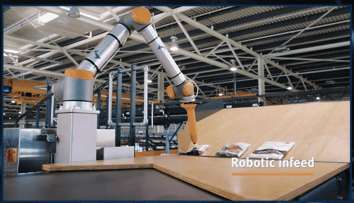In the previous episode of our Logiconomi TV series we learned from Hans Larsson, Director of Strategic Innovation at Toyota Material Handling Europe, that the continued growth in e-commerce, and a general shortage of labour in the market are two significant trends currently.
This forces many companies to look for new, more resilient ways to organise order assembly. As a result, a clear trend today is a move towards solutions that support the goods-to-man concept, as opposed to sending people out on picking rounds.
In this episode of Logiconomi TV, Lotte Willems of Vanderlande explains the latest developments in robotics, and Guillermo Albaladejo, General Manager of the Logistics Solutions Integration team at Toyota Material Handling, discusses developments in software-driven automation.
The rise of the AMR
Guillermo states that there has been a lot of creativity in recent years, blending different storage methods and technologies. Many solutions are still based on the concept of a racking system with access aisles. They are generally described as automated storage and retrieval systems (AS/RS) - or mini loads.
In these AS/RS, an element which is usually a crane runs in a corridor or aisle to retrieve items and bring them to a workstation. This technology has existed for decades, so maintenance costs can be quite affordable, as it is easy to find maintenance companies. The space used can be up to more than 30 metres and when the throughput, the speed of the machine, is not too high then the cost per location is relatively low.
These solutions are still suitable for some applications but are definitely in decline. There is a clear trend towards autonomous mobile robots (AMR) or Robot Shuttles. AMR is kind of a buzz word these days. It’s a competitor of crane systems because it's kind of a crane, but you can go into the aisle and retrieve the product and bring it to the operator.
What are the main benefits of AMR shuttles?
Instead of having a single crane per aisle, you can have a hive of robots roaming the space. Another benefit is that they can bring the picked items directly to the point of order consolidation. They do, however, have some clear disadvantages compared to mini loads, like limited operating height. Mini loads will continue to be useful when few stock keeping units are moved, at only medium to slow rates, in manufacturing environments for instance.
Still, Guillermo continued, if you walked through Logimat in April you know that AMRs are everywhere. The fair was filled with different technology providers offering mobile robotics. One of the reasons for this boom is that the majority of new automation users are those who invest in smaller contracts, like companies that have never automated before, or large companies investing in tactical projects. AMRs are often a good fit for these types of projects. They are easy and fast to implement, and the entry ticket to invest is generally lower than with other technologies.
Watch a short teaser of the latest Logiconomi TV series
Other notable technologies out there right now
The other key area is cube based AS/RS, where the aisle is eliminated, resulting in much higher storage capacity. AutoStore is probably the most famous one but there are other companies as well. The logic is completely different because products are stacked on top of each other - they are not placed into aisles - which gives the advantage of density.
Of course, having moved the goods to the order assembly area, there is still the need to select individual items. This is traditionally the task of manual labour. However, robots are becoming an increasingly attractive alternative.
Robots enter the assembly stage
![]() That brings us to Lotte Willems. Vanderlande is well-known for goods-to-person solutions that take items to workstations for final order assembly and reduce the dependence on people - but now they are going one step further and develop robots for the assembly stage as well.
That brings us to Lotte Willems. Vanderlande is well-known for goods-to-person solutions that take items to workstations for final order assembly and reduce the dependence on people - but now they are going one step further and develop robots for the assembly stage as well.
There are three driving forces here, according to Lotte. Firstly, supply and demand in the labour force. Many companies are simply unable to find enough people to do the job manually. Secondly, cost - because people are very expensive today. And thirdly, resilience. We have seen the impact of the pandemic, and companies are looking for ways to maintain a certain level of reliability in their operations because they don't want to let their customers down.
A convincing business case
“Does it make sense? Is it a good business deal?” Lotte questions. Therefore, she likes to keep it as simple as possible, which is basically a back-of-the-envelope business case. Let’s assume you have a double shift operation. Then you need three people, normally two operators and one workstation.
By way of example, in the Netherlands the fully burdened employee costs are €60,000 per person a year. Hence, your operational expenditure is €180,000 per year adding up to almost 2 million over a 10-year period. A robot also has some operational expenditure. Why? Well, you need to pay for a software licence. With artificial intelligence you still need to make sure there’s an operator overseeing multiple robots and you also need to teach the system which item it can and cannot pick. So, let's assume that this also costs €60,000 and a work cell itself is €250,000. Then your operating expense is reduced by 67% and over the 10-year period you are saving 1 million Euro. And that's only one robot. Imagine what happens if you do the math for 10 or 20 robots?
How Vanderlande deals with a robot’s limitations
The reality is that robots typically use suction to pick up items, so the characteristics of the goods will dictate whether or not they are suitable for robot-picking. For example, a single lemon will be no problem, but a mesh bag of lemons will cause difficulties. Some items are too heavy, and others may need additional devices like barcode readers - for instance packs of cheese that have different weights - so the robot scans the barcode whilst picking and then transmits that data so that the customer is charged correctly. 
You need to consider packaging in order to increase the robot’s pickable item sets. Luckily, artificial intelligence is there to help us to deal with the changes in all the product categories. A product can become bigger, or it can have a sticker on it. It can change its appearance - it doesn't matter - artificial intelligence can deal with it. As an integrator, we have to make sure that we guide the right product to the right workstation, so you don't need to worry about sending it to the right robot or not. We as an integrator make sure that your system can do that automatically.
The idea is to have both robotic and manual assembly stations and to send the goods to the right station in order to optimise the picking process. Technology is improving all the time. In the last few months, Vanderlande has developed a new suction cup swapper which increases the capability of the robot. Robots can now pick smaller and heavier items.
The future of automation in your operation
Technology clearly has a big impact on traditional labour, in the world of order picking, helping to address the labour force challenges and to improve resilience levels. New technologies will start contending for market share, which tends to lower costs for end users.
 Guillermo Albaladejo believes that with the explosion of technology development many of the solution providers will not be around in 10 years. It is very important for both investors and end users to recognise this risk and wisely choose the technology provider or integrator they want to partner with in these strategic investments.
Guillermo Albaladejo believes that with the explosion of technology development many of the solution providers will not be around in 10 years. It is very important for both investors and end users to recognise this risk and wisely choose the technology provider or integrator they want to partner with in these strategic investments.


.jpg?width=351&height=198&name=LTV_EP8_Screencapture%20(1).jpg)



